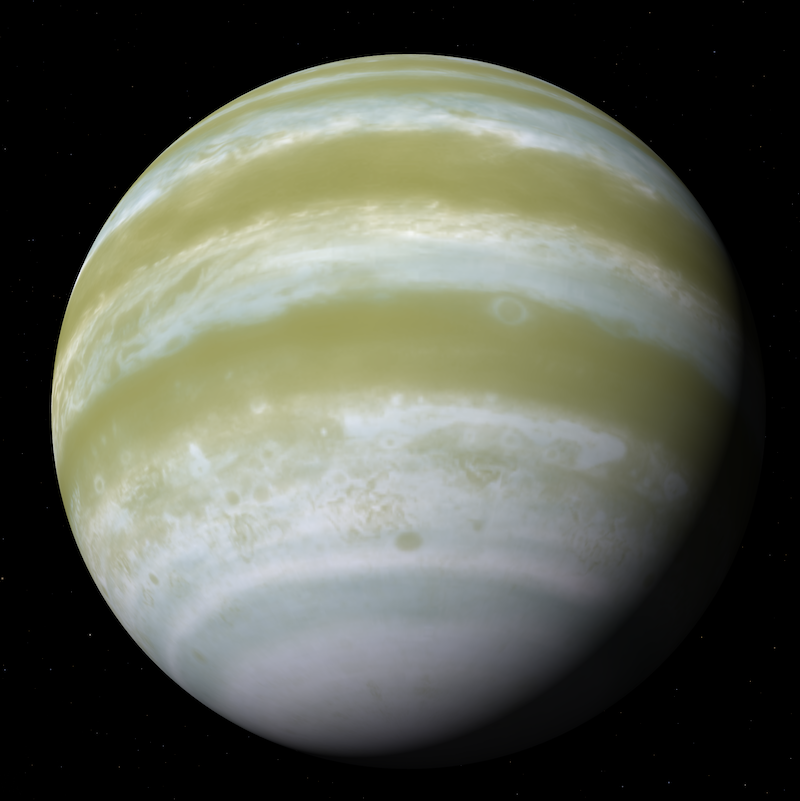Now Reading: Double hot Jupiters: How do these rare gigantic worlds form?
-
01
Double hot Jupiters: How do these rare gigantic worlds form?
Double hot Jupiters: How do these rare gigantic worlds form?


- Hot Jupiters are gas giant exoplanets that are similar to Jupiter or Saturn but orbit very close to their stars. As a result, they are searingly hot.
- Most hot Jupiters orbit single stars, but there are also double star systems with a hot Jupiter orbiting each star.
- The double hot Jupiter systems form in a similar way to those around single stars, but in a “mirrored process.”
What are double hot Jupiters?
So-called hot Jupiters are fascinating worlds. They are gas giants, like Jupiter or Saturn, but orbit very close to their stars. Consequently, they are searingly hot. Astronomers have found most of them around single stars. But sometimes they can exist as doubles, too. This happens in binary star systems – where two stars orbit each other – and there is a hot Jupiter orbiting each star. How do these intriguing exoplanet systems form? On June 18, 2025, researchers at Yale University in Connecticut said these hot Jupiters are the natural outcome of the evolution of binary star systems.
Single hot Jupiters are rare, found only around about 1% of stars. Double hot Jupiters are even more rare. Hot Jupiters challenge previous ideas of how planets form. The researchers will also use the new findings to help search for more double hot Jupiters.
The research team published its peer-reviewed results in The Astrophysical Journal on June 10, 2025.
This animation depicts how double hot Jupiters form. Video via Tiger Lu/ Liu et al./ The Astrophysical Journal/ YaleNews.
Yale University: New Study Offers a Double Dose of “Hot Jupiters” news.yale.edu/2025/06/18/n…
— AAS Press Office (@press.aas.org) 2025-06-20T16:48:44.340Z
How to create double hot Jupiters
Scientists said hot Jupiters can form when a gas giant planet farther out in its solar system, with an unusual orbit, moves closer in to its star. The gravity of a secondary object can cause this to happen. This process is called Zeipel-Lidov-Kozai (ZLK) migration.
Malena Rice at Yale University, one of the three authors of the new paper, said:
The ZLK mechanism is a dance of sorts. In a binary system, the extra star can shape and warp planets’ orbits, causing the planets to migrate inward.
But what about double hot Jupiters? They are rarer than single hot Jupiters, but they do exist. The researchers used numerical simulations to see how systems of two stars and two planets would evolve over time. The results showed that the same general process occurs, but for each star instead of just one star. Rice said:
We show how planets in binary systems can undergo a mirrored migration process, so that both stars end up with hot Jupiters.
Co-author Yurou Liu added:
With the right code and enough computing power, we can explore how planets evolve over billions of years; movements that no human could watch in a lifetime, but that still could leave imprints for us to observe.

Challenging concepts of planetary formation
Hot Jupiters are fascinating for astronomers, since they don’t seem to quite fit with previous concepts of how planets form. We have Jupiter and Saturn in our solar system, of course, but they are much farther from the sun than Earth is. There are no hot Jupiters in our solar system that we can study. Liu said:
We would expect giant planets to form far away from their host stars. This makes hot Jupiters both accessible and mysterious, and a worthwhile subject to study.
Co-author Tiger Lu added:
Our proposed mechanism works best when the stars are at a moderate separation. They need to be far enough apart that giant planets are still expected to form around each star, but close enough together for the two stars to influence each other during the system lifetime.
The findings offer a new glimpse of planetary systems quite unlike our own. Our sun is not a binary star and our solar system has no hot Jupiters. So systems that have both binary stars and double hot Jupiters are uniquely alien and fascinating for scientists.
Bottom line: A new study from Yale University shows how double hot Jupiters can form in binary star systems. These exoplanets are similar to Jupiter but searingly hot.
Source: The Formation of Double Hot Jupiter Systems through von Zeipel–Lidov–Kozai Migration
Read more: The unexpected, exotic characteristics of hot Jupiters
Read more: This gigantic searing hot exoplanet began its life very cold
The post Double hot Jupiters: How do these rare gigantic worlds form? first appeared on EarthSky.
Stay Informed With the Latest & Most Important News
Previous Post
Next Post
-
 012024 in Review: Highlights from NASA in Silicon Valley
012024 in Review: Highlights from NASA in Silicon Valley -
 02Panasonic Leica Summilux DG 15mm f/1.7 ASPH review
02Panasonic Leica Summilux DG 15mm f/1.7 ASPH review -
 03From Polymerization-Enabled Folding and Assembly to Chemical Evolution: Key Processes for Emergence of Functional Polymers in the Origin of Life
03From Polymerization-Enabled Folding and Assembly to Chemical Evolution: Key Processes for Emergence of Functional Polymers in the Origin of Life -
 04How New NASA, India Earth Satellite NISAR Will See Earth
04How New NASA, India Earth Satellite NISAR Will See Earth -
 05And Thus Begins A New Year For Life On Earth
05And Thus Begins A New Year For Life On Earth -
 06Astronomy Activation Ambassadors: A New Era
06Astronomy Activation Ambassadors: A New Era -
07SpaceX launch surge helps set new global launch record in 2024




















